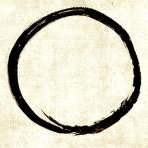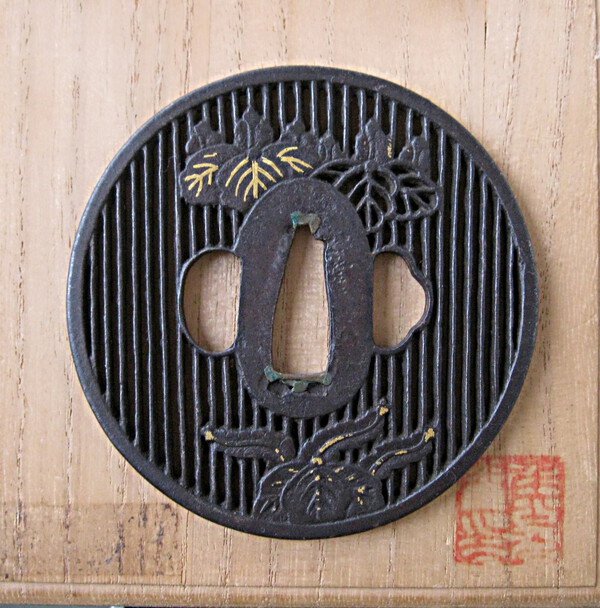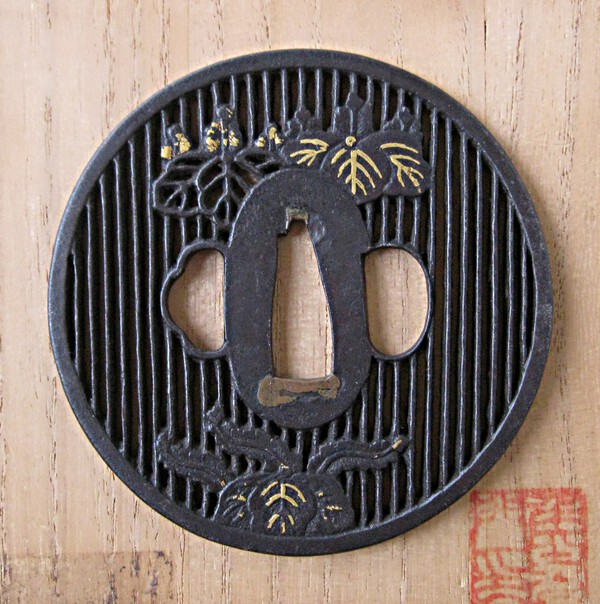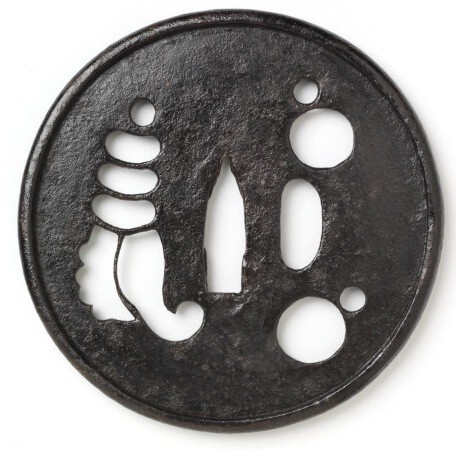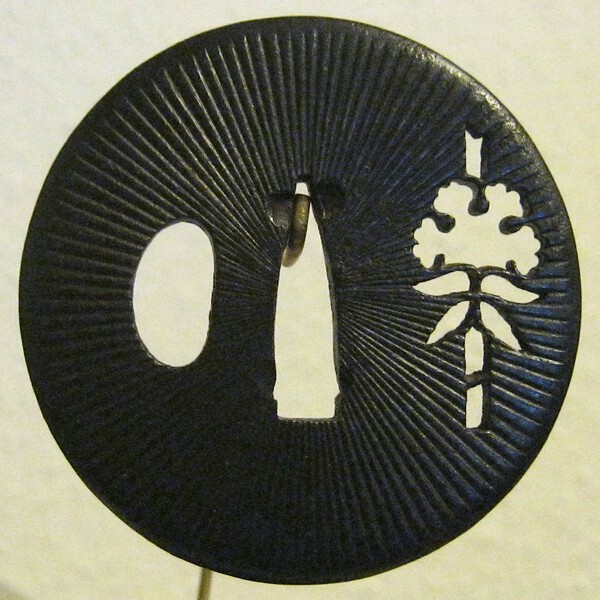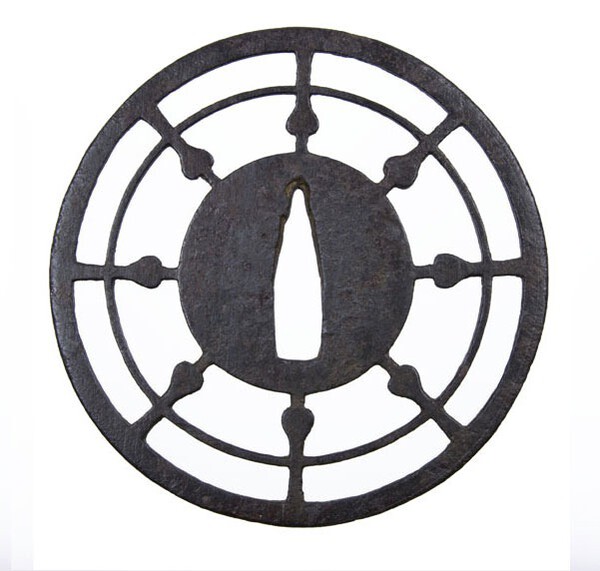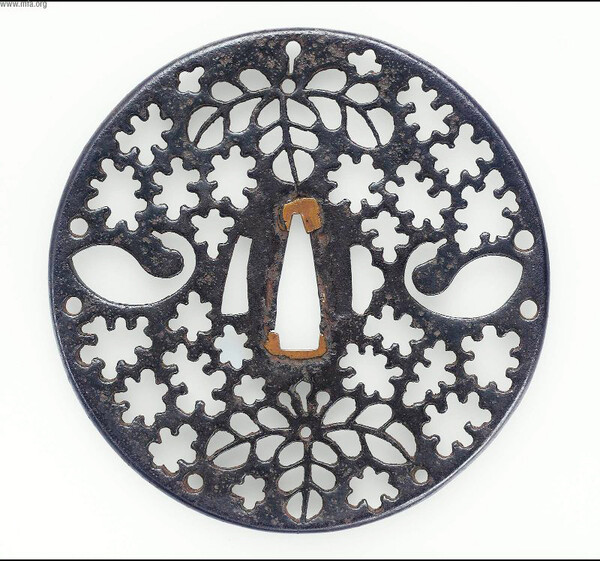-
Posts
407 -
Joined
-
Last visited
-
Days Won
1
Content Type
Profiles
Forums
Events
Store
Downloads
Gallery
Everything posted by FlorianB
-
Hello all, I would like to show You a Tsuba I own (sorry for the mediocre pictures): It is exactly marugata (7,78 x 7,78 cm) and 0,45 mm thick. There is no niku and the rim is kaku-mimi. The kiri are executed in flat relief and accentuated with gold nunome. I’m fond of the very thinly executed lattice. The irregularities inside the lattice are rust particles, not looking good, but certainly not to remove. Although I have some ideas by myself I like to ask for Your opinions concerning school and age. Thank You, Florian
-
I stick to my impression that this is the original shape. The mentioned variations in shape are foremost result of the maker’s creativity and only sometimes a practical use could be determined. There are examples of Tsuba with flattend rims to avoid a rolling away if the Sword lies on the ground. Maybe this could a reason here, too, if You look for some... I agree wilh Steven that this Tsuba is not a formal one at all. Formal tsuba should show the kamon of the owner. Florian
-
There are so many variations in keijo I persume this could be the original shape looking like a fundo. Strange anyway. The rim has to be closer examined to clearify this. However a Tsuba of decent quality. I have no idea what the person (if it is one) represents, maybe some kind of chinese sage... Florian
-
Hello Romy, according to the “Sword and Same”-book by Joly/Higotaro I would agree the bonji on the omote above the ken is “Fudô Myoô”, the upper on the ura could be “Dainichi Nyorai”. The others are very simplified and I could only speculate “Tamonten” and “Monju” - but that’s a shot in the dark. Alas the bonji shown in the web seem to be almost always just reproductions from the above mentioned book (first published in 1913!), a resource for the simplified ones is obviously missing. Florian
-
More likely nothing changed in the V&A since Mr. B. W. Robinson's days in the 1960ies ... Florian
-
The overall appearance, the elongiated hitsu-ana and irregularities in the sukashi (later ones are more exactly made) make me believe it must be Ko-Tosho, probably late Muromachi. Size and thickness of about 3 mm could be found on similar specimen, too. The lower elements could also be interpreted as a tumbler or kukurizaru frequently found on this kind of Tsuba. Early kukurizaru show a small circle connected with a kidney-shaped form, later ones just two circles of different sizes. Found this at the V&A Museum: But moon and star work in Yours as well - as You like it. Very nice piece! Florian
-
No measurements and slightly blurry pictures make it not easy... Seems a very short but healthy blade with a top grade horimono and pointed nakago. That’s why I guess one of the Gassan smiths like Sadakazu or Sadakatsu could be considered. But it’s just a shot in the dark. Florian
-
Size doesn't matter. For those who like curiosities. Florian
-
Looks like the remains of a long blade. The tip is poorly reshaped. But I wonder someone made a new koshirae for this. Florian
-
Alas I have no idea about a school but because of the fan-shapd sukashi, the sharp angeled nakago-ana and the mentioned niku I would put it into the Edo-period. Certainly it appears older due to corrosion and apart from that an old look (some sabi-feeling...) was maybe intentioned. Florian
-
It could be possible that these ornaments are Kamon, but it’s more likeley they are simply design. The mon are embossed by stamps and such decorations could be seen frequently without any heraldic relevance. Florian
-
A friend of mine sees a relation to Akasaka. Indeed there are common traits like size and thickness, the niku, the small, offset kozuka-hitsu-ana and the slight conical shape of seppa-dai - though no sanmai-awase. My friend supposes it could be some kind of proto-Akasaka still without layered steel. Any suggestions to this idea? Florian
-
Ko-Shoami was my first choice, too, because of the archaic and unconstrained look. But angular hitsu-ana were also produced in later times, so Shoami of Edo-period seemed another option. By the way, I have another Ko-Shoami of about the same thickness. Owari came in to my mind as well, but in this case it must be a late one and should be more refined than this. Lack of refinement and the smaller seppa-dai speak in my opinion against Akao. Mauro, Your picture is interesting. Have a look at this one: Clearly the same specimen and depicted in a 1976 reprint of the “Red Cross” Catalogue from 1916. Not actually a textbook, mere a picture book and this Tsuba is claimed in here as “Kanayama nenuke”, 17th century! Florian
-
Gentlemen, I’d like to discuss my latest acquisition. This Tsuba measures 77.5 cm x 78.8 cm, the thickness at the seppa-dai is 0.65 cm, at the rounded rim 0.6 cm. The design comprises warabite and matsukawa-bishi. Although I’ve done research yet, I’m uncertain of a definite attribution. That’s why I ask for Your opinions concerning school (or “style” as some of You would prefer) and age. There isn’t any paper so feel free to speculate. Furthermore: Is there a special meaning in combination of warabite and matsukawa-bishi? Thanks, Florian
-
Gentlemen, indeed we do not much really know about Tsuba. The whole classification-system we follow today came from later times especially out of the middle of the last century, based on comparing and looking for similarities. This system is far from perfect and all those “cross-over” pieces prove this. There is, however, no other or better system. Dealing with Tsuba would be rather boring simply to state that someone made a piece at some time in the past somewhere in Japan. In respect classifying seems obviously a desire of man - why not speculate further and put a Tsuba in a labled box? Florian
-
My first impression was Owari but the somewhat unique design make me agree with Kanayama. It is said their Tsuba are thick but there are also thinner ones, probably a later one. The smooth surface could be migaki finish and would proof an Edo period origin. Is there a shot of the missing part? I wonder if it was removed for fitting or omitted purposely. I’m also curious about the circular tagane with riffles. Florian
-
Hello Grev, sorry for misunderstanding. Alas I can’t catch exactly Your second question. Concerning the Edo-Tosho-piece it is IMHO made of iron with a polished surface (migaki) usual in Edo-Period (mine shows the same). Shakudo wouldn’t look like this, even if rubbed. Further shakudo and other material mixes are made very fine so that neither rough traces of wearing nor tekkotsu wouldn’t appear. Concerning the second Tsuba with the kebori-Design I must admit my lack of knowledge, but judging by the picture I think it is made of iron, too. The polished surface isn’t glossy but could be heighten by rubbing with cotton. At last the Ko-Tosho Tsuba shows a lustreless surface and it appears there is initial rust. Deer antler and cotton cloth would help enhance its beauty, too. Florian
-
Grev, You seemed to be a bit disappointed because this Tsuba isn’t a Koto one. In my younger days when I have had neither money nor knowledge I purchased this late Tosho-style-Tsuba: Fortunately most of the rubbish I bought in those times has gone again but although I know it’s only a humble piece and despite meanwhile I own better specimen I kept it until today because I simply like it. So know what You have and enjoy Your Tsuba! Florian
-
Difficult to identify without closer inspection. Could be traces of corrosion or tekkotsu which is slighty rubbed. But alas in case of the latter that’s not a hint to pre-Edo-times. There’s a round spot, too, (5 o’clock position) maybe the remains of some glued label. Florian
-
It is thicker as Ko-Tosho, the thickness decreases at the rim and the sukashi is more sophisticated. You’re right, a typical example for a later Tosho-style-Tsuba. Florian
-
John, this is an interesting Tsuba and I haven’t heard of this school yet but IMHO it can’t be compared properly with the above one because of the nunome, the sharply angled edges and the different surface. Pat, if the paper would put the Tsuba down to Shoami I persume this topic wouldn't have been started. I don’t want to harp on the reliability of papers again because we have had discussions about doubtful attributions frequently and not long ago even one of my own Tsuba was mooted here thus. But on the other hand the first thing is to assume that an attribution is correct. Only if after proper research another option seems more probable a paper could be certainly questioned. Florian
-
In addition here are two examples of Ko-Katchushi-Tsuba without raised rim and it’s easy to find more of them. If a Tsuba in "Tosho"-style shows large areas of sukashi it is claimed as Katchushi. Probably this is the reason for the attribution of the Tsuba in question. Florian
-
If I remember correctly, Katchushi Tsuba haven’t always a raised rim. Those karigane arranged in a circle are often to be seen in different schools. But where to put the broad rim into? I haven’t seen this in Owari or Akasaka as supposed. The archaic look, large size, surface obviously without niku and a rather thin thickness (of course thicker than in pre-Edo) - I can live with this attribution. If there woud be inlays or something else I would have other ideas... Florian
-
I’ve seen this, too, and was also astonished at first, but I can’t single out another school. Taking into consideration that it is a later one which is more sophisticated, the attribution seems to be the best guess and I have no doubts concerning the reliability. Florian
-
Yes, moon and stars. Stars are frequently connected with lines, this look is unusual and reminds me to dew-drops. I agree with the Akasaka attribution, probably a later piece. Indeed the "three-layer-construction" wasn't made everytimes. However, a good looking specimen in design and metal. Florian


